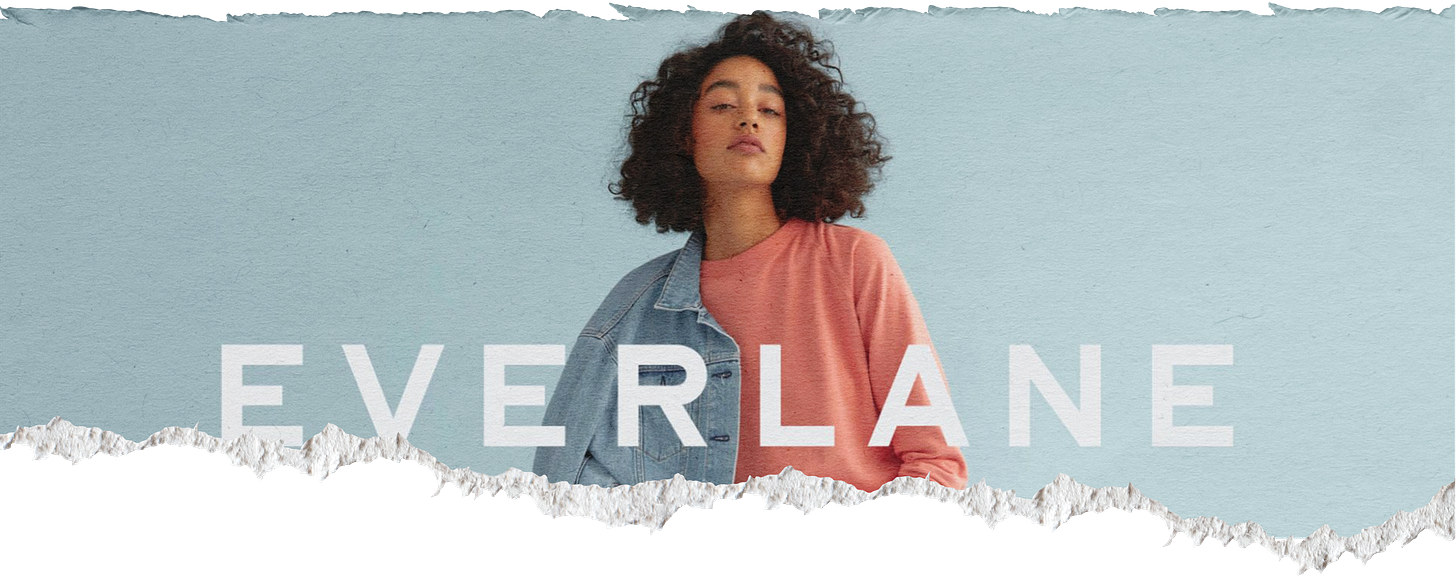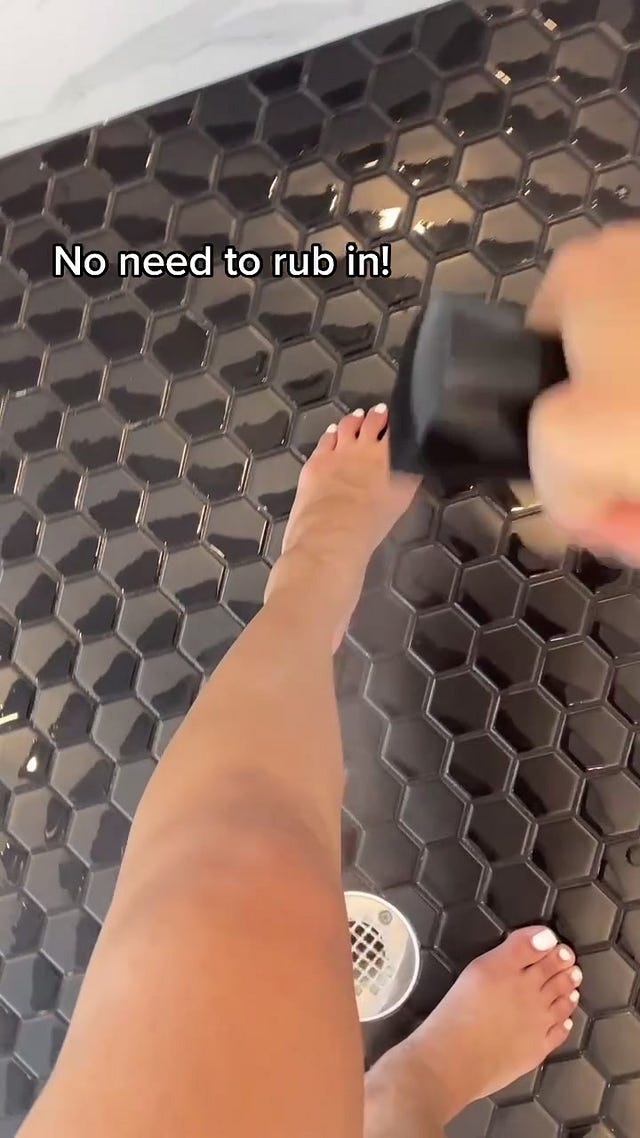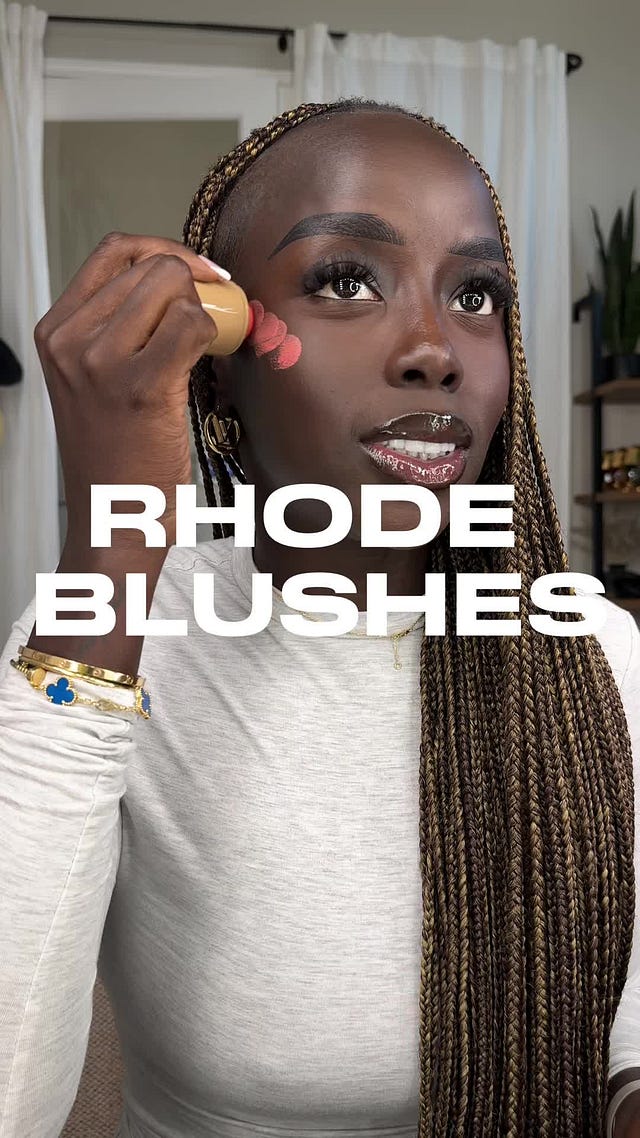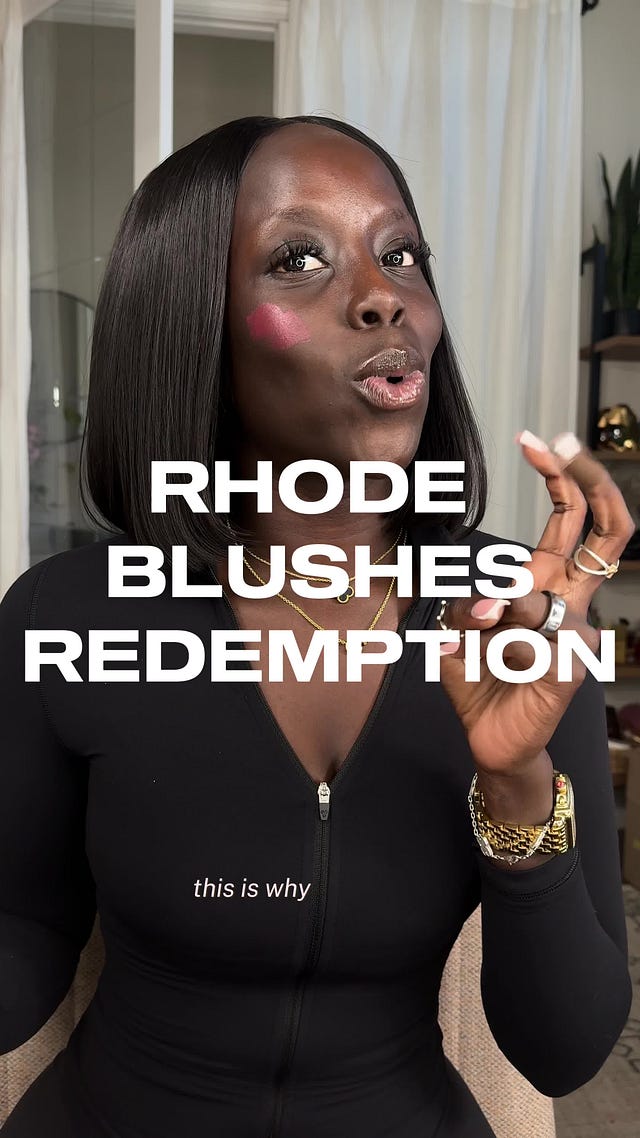Beyond the Buzz: Co-Creation
Co-creation is on the rise. Here’s what it is, what it isn’t, and what I think it takes to get right.
Welcome to Beyond the Buzz, where we decode the buzzwords echoing through every meeting room and brand deck from here to the beauty counter. You know the ones 👀 —those perfectly polished phrases your marketing team is guaranteed to use at least three times in a presentation.
Living that double life of strategist-slash-shopper, I often wonder: do these words actually deliver, or are they just smoke and mirrors? (spoiler: there's plenty of both). Each week, we'll unpack one of these marketing darlings, along with receipts 🧾 on who's walking the talk and who's just adding to the noise.
In my last article in this series, I dove into all things community from a brand POV. And readers, your interest (thank you SO much!) told me loud and clear that you’re just as fascinated by communities as I am. So, diving into co-creation felt like a natural segue.
“Co-creation” isn’t nearly as overused as “community” (yet!), but as brands frantically search for deeper connections with consumers, it’s quickly climbing the buzzword charts.
For some brands, co-creation is a way to make consumers feel included and develop that coveted emotional bond.
For others - whose finance teams are staring anxiously at all those zeros they've invested in building owned communities - it’s simply about maximising ROI.
The Co-Creation Juice Might Just Be Worth the Squeeze
CK Prahalad and Venkat Ramaswamy (the OG co-creation gurus who literally wrote the book on it) outlined four ways true co-creation benefits both sides of the beauty counter:
💰 Increases returns and strategic capital for the brand: Beauty brands often spend 15-20% of development costs on clinical testing, focus groups, and market research. Meanwhile, co-creation provides real-time, authentic feedback that’s often more valuable than traditional research, helping brands spot emerging preferences faster than competitors in our notoriously trend-driven industry. Plus, consumer perception testing can cost just 1/4 of the price.
📉 Lowers risks and costs for brands: While over 25% of total revenue and profits cross-industry come from new product launches, more than 50% miss their targets. Co-created products have pre-validated demand and allow formula adjustments before going into full-scale production.
✨ Provides consumers with new, valuable experiences: The exclusive co-creation experience, in its own right, adds value beyond the physical product. Remember Jacquemus’ iconic handbag vending machines? They helped land the brand on Lyst's Index of fashion's hottest brands. The experience itself became the luxury.
⚠️ Reduces risks for consumers: With our diverse body, hair, and skin types, beauty products pose a significant personal risk, both financially (“did I really just spend $75 on THAT?”) and physically (“why is my face suddenly breaking out?”). Co-creation reduces purchase anxiety not just for participants but for all consumers who identify with the co-creators.
When we see people like us involved in product development, we intuitively trust that our concerns were considered. The State of Fashion 2024 found that 43% of consumers now rely less on traditional influencers vs. previous years, and 43% prioritise relatability and authenticity in creators. We want to know products were made for us, not a Vogue-cover fantasy.
Not All ‘Co’ Is Created Equal
If you’re getting déjà vu from my community article, it’s because we’re seeing the same pattern: brands intending to do something transformative, but ultimately just repackaging business as usual.
Let’s spot the impostors:
🤳🏽 The Instagram Poll Illusion: A haircare brand asks followers to vote between jar or tube packaging for their new mask, then claims the product was “co-created with our community,” despite every formulation decision happening behind firmly closed doors.
👥 The Obligatory Focus Group: A skincare brand runs a standard one-time focus group, then markets its serum as “developed with real women,” but never shows how (or even if) that input shaped the final product.
👩🏼🎨 The Creator Not-Quite-Collaboration: Our makeup fave partners with the ‘Influencer of the Moment™’ for a limited edition palette where the creator merely picks from pre-determined colour options and promotes the final product - with no dialogue or meaningful decision-making throughout development - yet the brand advertises it as a ground-breaking 360° partnership.
I’m not saying these approaches have zero value. That Instagram poll increases engagement, focus groups provide qualitative insights, and influencer partnerships bring fresh perspectives and expanded reach. But let’s call these what they actually are: market research and curation, not co-creation.
True co-creation challenges us to evolve from B2C (the traditional one-way approach where businesses create products and market them to consumers) to C2B2C (Consumer to Business to Consumer) – a circular approach where consumer needs drive business decisions, which then create products that better serve consumers, who further refine them through ongoing feedback.
It’s a shift that takes you from expanding your foundation range to 40+ shades based on internal decisions to working alongside consumers with diverse skin tones throughout development.
So... What Is Co-Creation, Actually?
At its essence, co-creation is about shared authorship. It happens when brands and consumers work together throughout the entire product journey and go beyond asking for opinions towards actively involving consumers as partners in creating something that delivers value to them.
If we go by the original thinkers who coined the term - not because they need to be the eternal definitive word on the topic, but because buzzwords usually become buzzwords because they’re missing any kind of real definition - they offered us something called the DART Framework.
It’s a helpful pulse check for whether what our brands are doing qualifies as co-creation or if it’s just a slightly more interactive version of what we were already going to do:
🗣 D for Dialogue: Beauty has historically been one-way communication, with brands telling consumers what ‘beauty’ is. Co-creation reverses this by inviting authentic customer voices to shape the narrative.
🔑 A for Access: Traditional beauty development is secretive (labs, proprietary technologies). Co-creation opens this up, giving customers behind-the-scenes access.
⚠️ R for Risk Assessment: Beauty products carry various risks (colour mismatches, adverse skin reactions, unmet performance claims). Are we transparent about what products can and cannot do? Co-creation allows honest discussions about these limitations.
🔍 T for Transparency: Consumers are asking deeper questions - not just what’s in the product, but why it costs what it does, where the ingredients are sourced, and what ethical choices were made. Co-creation demands visibility.
We usually hesitate about co-creation because we feel a level of uncertainty about sharing creative control. But, there’s a paradox, because the brands that embrace it tend to discover more strategic advantage, not less.
DART, Dissected: How Each Element Shows Up Across Brands
Kory Marchisotto, CMO of e.l.f - one of the most community-driven brands of the 2020s - fosters 🗣 dialogue by intentionally keeping zero distance between the community and the C-suite team. She personally reads comments across their socials and prioritises taking fast action on what she sees. In fact, the launch of bronzing drops (credited for driving a 50% increase in revenue for the brand) came after she called the CEO into a livestream where 5,000 viewers requested the product. He, in turn, had the innovations team immediately kick off development.
Seed Beauty, the company behind ColourPop, has been facilitating 🔑 access since at least 2017, inviting millions of fans directly into their lab - virtually - as “product development specialists.” They saw early formulas, gave real-time feedback, voted on final shades, and helped the brand go from concept to launch for a new highlighter, blush, and eyeshadow in only four days. According to CEO John Nelson, “This is the type of direct interaction with fans that blows up the old way of developing new products.”
Paula’s Choice, an incredibly trusted skincare name among the ‘skintelligent consumer’, has long embraced ⚠️ risk assessment by prioritising transparency around what ingredients can’t do, not just hyping what they can. Paula Begoun famously launched the business after getting fired from a retail job for refusing to lie to shoppers.
Today, more than two bottles of their cult 2% BHA Liquid Exfoliant are sold every minute globally, and the brand continues to earn loyalty by educating consumers with blunt, evidence-based content. Their site includes ingredient myth-busting articles (even for their products), and in 2023, they launched Beautypedia, a tool that lets users review the ingredients of any product - from any brand - and understand the science behind it.
Everlane, though outside the beauty world, has become a standout reference point for 🔍 transparency by showing just how far a brand can go when it comes to costs, materials, and sourcing.
Every product page includes a full cost breakdown - from materials to labour to transport - and another features a public spreadsheet with their global factories. It’s bold, but it worked: the brand passed $100 million in annual revenue within five years of launch and had its most profitable year in company history in 2023.
I must say: I fully get why this level of radical transparency can feel risky. There’s the fear of capping your markup, showing competitors your hand, and oversimplifying a complex mix of intellectual property, production scale, and strategy. But, not all transparency needs to feel that exposed.
Aveda allows consumers to trace select ingredients back to their source via blockchain technology, offering reassurance around ethics and sourcing without revealing sensitive cost structures or formulas.
It’s a more guarded form of transparency that still signals care, accountability, and respect for an increasingly curious customer.
It’s worth noting that many of these examples do not represent full-spectrum co-creation.
They’re not all inviting consumers into the lab and the boardroom and the campaign edit suite. But each brand demonstrates one key DART principle in action, which matters because spotting these signals means the industry is slowly inching closer to something more participatory and human.
When Their Behaviour Becomes the Brief
When researching what co-creation really is for this article, I discovered that it can flow in two ways. The first - and probably the one we’re most comfortable with as marketers - is outside-in co-creation. This starts with the consumer’s lived experience. We observe how they’re already adapting, mixing, layering, or hacking products to suit their needs, and then build around that.
Do you know how your Beautyblender came to be? 👀
Surprise! It wasn’t a trend forecast. It came from founder Rea Ann Silva noticing how on-set makeup artists were cutting sponges into rounded shapes for better blending. That behaviour became the blueprint, and she launched a new category that had sold over 50 million units worldwide by 2021 and had her recognised by the Smithsonian as a literal game-changer in beauty.
One of my personal favourite examples of outside-in co-creation is Isle of Paradise. The brand’s Self-Tanning Water had been a hit for a while, but it was TikTok that made one thing clear: they were decanting the product into continuous mist spray bottles for an easier and more even application.
 Tiktok failed to load.
Tiktok failed to load.Enable 3rd party cookies or use another browser
Isle of Paradise didn’t ignore it or just “lean in” with a hashtag. Instead, they built a whole new product. In under six months, they launched the Pro Glow Spray Tan Kit, which included a continuous mister and a refill of the tanning water - all directly inspired by how people were already using it. It sold out within 48 hours.
Another brand that deserves credit here is eos. While not a full product formula co-creation, their “Bless Your F*ing Cooch” campaign showed what it looks like to let go of control and speak to our audience in their language, even when it’s... unconventional to the point of probably making any risk-adverse CEO flinch.
 Tiktok failed to load.
Tiktok failed to load.Enable 3rd party cookies or use another browser
In 2021, after a TikTok creator went viral for sharing her shaving routine (complete with candid instructions using eos’s Shea Better Shave Cream), the brand moved fast, printing her words directly on the packaging and launching a limited-edition line built around her phrasing.

The results?
💳 150,000 units were sold within the first week of launch
👩🏾💻 Achieved a 450x spike in site traffic
🗞️ Secured over 700 million earned media impressions
🛒 Elevated eos to the #1 shave brand at Target for both men and women, while the product's ranking on Amazon soared from 300,000 to 15,000
🏆 And it garnered multiple covetable accolades, including a Clio Grand Award and a Silver Cannes Lion
It worked because eos let the creator lead the storytelling. They resisted the urge to clean it up and instead reflected her words the exact way the community had embraced them - even though her TikTok wasn’t even beauty-focused!
The result was a cultural moment that deepened the brand’s connection with a new generation of consumers.
It targeted Gen-Z by simply trusting them.
And while the campaign technically centred on one creator, the message was “we see you, we hear you, and we’re not afraid to speak your language”, which feels like a true act of partnership even without a formal co-creation brief behind it.
In some cases, listening to your community has even served as an essential strategy for what I can’t help but dub ‘reputational redemption’.
In August 2024, beauty creator Golloria George posted a TikTok review of Rhode’s Pocket Blushes, calling out their lack of inclusivity for deeper skin tones. Her critique was direct, and it struck a nerve online. Instead of brushing it off, Hailey Bieber personally reached out, acknowledged the misstep, and invited Golloria to consult on reformulating the range.
 Tiktok failed to load.
Tiktok failed to load.Enable 3rd party cookies or use another browser
By March 2025, two new shades specifically designed to flatter deeper complexions (Date Cake and Plum), co-developed by Golloria and cosmetic chemist Ron Robinson, launched as part of the line.
Golloria shared the final result with her audience, noting:
“You see how beautifully flushed I am without looking ashy...
This is why you advocate for yourself.”
All of this might sound obvious: observe your communities, respond to what they’re already doing, and reflect their language back to them. But if it were, more brands would be doing it by now.
Co-creation as a concept has been around since 2004, but in practice, we’re still catching up. Case in point: The Ordinary only reformulated one of its hero products (the Hyaluronic Acid 2% + B5) based on consumer feedback in 2024.
“This is one of the first major reformulations we’ve done,” said Nicola Kilner, CEO and co-founder of The Ordinary’s parent company, Deciem. “We’ve made tweaks based on regulations, for example. But, in terms of reformulating based on consumer feedback, this [is] a first for us.”
If a brand seen as one of the gold standards of community engagement is just now starting to adopt these behaviours, that tells us how far there still is to go.
But What if the Brief Was the Invitation?
While outside-in co-creation starts with the consumer, inside-out co-creation begins with the brand. It’s driven by a decision to bring consumers in sooner to help shape the brief based on their needs.
Let’s think back to Rhode and Golloria’s collaboration: that moment didn’t have to come after post-launch backlash.
Shade range controversies have happened again and again in beauty, and we’ve seen what happens when complexion products miss the mark. So it’s really not hard to imagine a world where Rhode built the original shade range with creators like Golloria from the beginning.
There’s an entire ecosystem of creators - Golloria included - whose content revolves around testing products across different skin tones and undertones. They aren’t just sharing aesthetic opinions; they’re educating their audiences on colour theory, pull, pigmentation, and finish. (If you remember the Youthforia black paint debacle, you’ll know why this nuance matters.)
It’s not just about “light vs. dark.” It’s about olive tones, golden undertones, cool hues that turn grey, blushes that look warm in the pan but washed-out upon application.
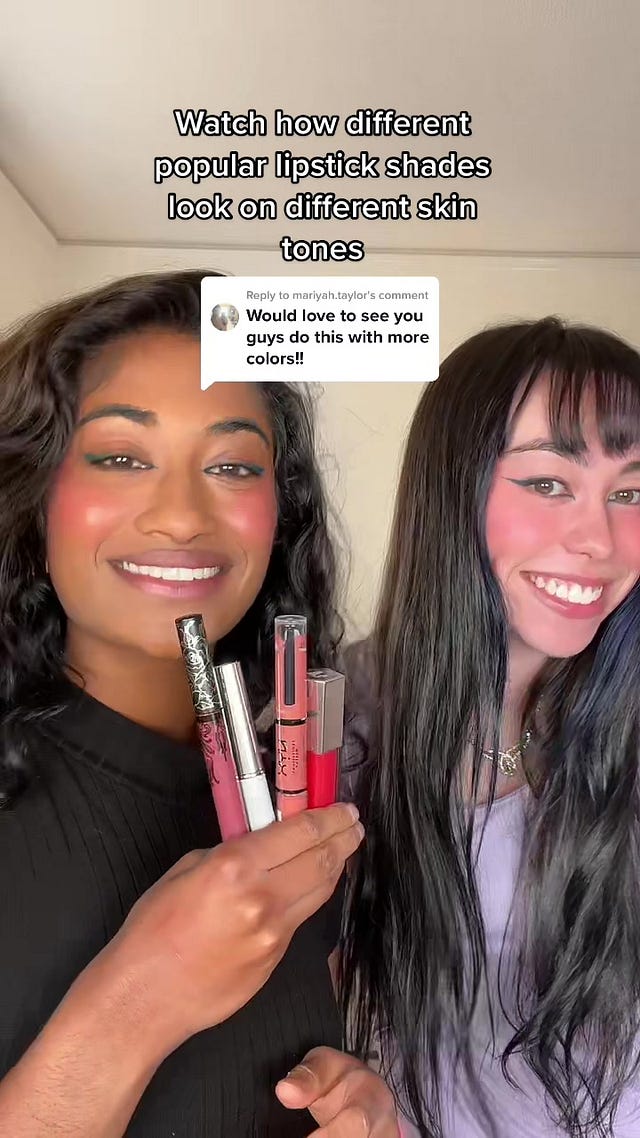
 Tiktok failed to load.
Tiktok failed to load.Enable 3rd party cookies or use another browser
Imagine a ‘dream team’ of creators like Golloria, Nyma Tang, Monica Ravichandran, Miss Darcei, and other tone experts participating in the formulation. A co-created colour range that does shade inclusivity right from the start, by a brand known for its aesthetics, attention to detail, and hype.
Inside-out co-creation isn’t rare because consumers don’t have the insight (they do) or because the industry lacks creators ready to collaborate (it absolutely doesn’t), but because involving people earlier does have a big impact on how decisions get made, and a lot of our workstreams aren’t readily set up to accommodate the process.
Interestingly, I’ve discovered that it’s French brands - not always the ones most associated with agility or digital-first thinking, and instead often associated with tradition, prestige, and heritage-driven storytelling - that seem to be leading the way here.
Take Nidéco. Launched in 2020, the skincare brand has built its entire model around consumer-led development. Consumers can pitch product ideas on the brand’s website, and once an idea hits 2,000 votes within 3 months, it moves into testing.
From there, 200 consumers are invited to help refine the formula, and - perhaps most surprisingly - if the product goes to market, the original co-creators receive €500 at the vote stage, €1,000 at launch, and a percentage of the product’s profits.
I know we won’t all be down for the profit-sharing. So if you’re wondering how to make co-creation the core of your brand without that element, or how this kind of thing could possibly scale, that’s fair enough.
That’s where personal care brand Respire comes in.
Also French, Respire launched in 2018 with a crowdfunding campaign and has since evolved into a full-blown consumer-powered brand. They sold 21,000 deodorants in their first month, raising €250,000, and never looked back.
Today, Respire runs a private Instagram group called La Ruche Respire with 400 testers, hosts bi-monthly in-person labs with 80+ consumers at their HQ, and bakes in their feedback at nearly every stage of development - from formula, to naming, to go-to-market strategy. Products must achieve a minimum rating of 4.5/5 from them before they’re released.
Fun fact: in 2023, they literally went door to door in a campaign called “J’irai me doucher chez vous” (“I’ll shower at your place”), touring France to meet their consumers IRL to talk about their routines and products in the most intimate of settings.
💭 Part of me wonders if they took a page from the Into The Gloss Top Shelf days - the same series that helped Glossier crack what their eventual shoppers wanted, years before launching.
For Respire, the intimacy is paying off:
💳 Over 5 million products sold by 2022.
📈 Consistent growth of 30% per quarter.
🏪 Stocked in over 3,000 retailers, including Monoprix, Sephora, and pharmacies - proof that a consumer-powered brand doesn’t have to stay niche.
While most inside-out co-creation case studies come from indie or emerging brands, it’s worth noting that even L’Oréal is experimenting with what this model can look like at an even larger scale.
In 2021, the brand’s U.S. Research & Innovation team launched the Beauty Co-Lab: a private online insight community made up of over 1,200 beauty lovers across haircare, skincare, and makeup. The objective was to give real consumers direct access to product prototypes quickly and route their feedback straight to the labs.

Participants tested formulas over days or weeks, shared detailed input, and influenced how products evolved before they hit the market. As of 2022, the Co-Lab was described as now playing a foundational role in their development process, reducing turnaround time and bringing consumer voices into conversations that usually happen far behind closed doors.
That said, it’s also been quiet. There hasn’t been much press around it, and I haven’t seen any product rollouts linked back to the Co-Lab. I’d love to see more visibility around what’s come out of it.
Plenty of newer cult brands like Bubble are leaning into co-creation language (private communities, polls and surveys within them, and sample gifting), but without clear visibility into how these insights shape the brand’s outputs, it’s hard to know how deep they’re going.
I Don’t Think Brands Can Build the Next Era of Beauty Alone
Co-creation isn’t new, but it is misunderstood. We have a pattern of treating it more like a marketing tactic than a structural choice.
While the examples in this piece range from fast pivots to foundational business models, it’s clear that consumers aren’t just reacting to what we launch; they’re writing our briefs for us.
They’re going deep in Reddit threads, WhatsApp group chats, DMs, TikTok stitches, Instagram comment sections, and livestream chats.
Consumers can give us far more value than picking a shade name from a list. They aren’t just looking to vote on packaging or be gifted samples for content, they’re looking for meaningful input on what gets made. That includes formulation decisions, product uses, and their emotional promises. They want legible language, price points aligned to their value perception, and results that deliver according to their real needs.
Of course, not every consumer wants to be equally involved.
Some are open to being part of every stage, and others just want to know someone like them was. We need to create flexible, tiered pathways for participation, from low-lift input loops to deeper development roles, and give consumers the ability to choose how they show up.
We don’t need to co-create every single product, but we’d greatly benefit from conditioning ourselves to stop seeing the market as solely a distribution channel and start treating it like an ‘ecosystem of dialogue’.
The good news is that many platforms that allow this already exist. What’s missing is how we’re using them:
🧴 Product pages could show the thinking behind the formula, not just the finish. We could share what feedback shaped each product, what ideas were left in the lab, and even invite suggestions for future versions.
📱 Our apps could go beyond tracking usage and routines and gather data to shape what comes next. Imagine if users could flag gaps in the routine builder that lead directly into the product pipeline.
🛍 In-store tech could do so much more. Smart mirrors and AR tools already help with try-ons, but what if they could also log tone mismatch frustrations or collect side-by-side user ratings of finish and texture? Every “this didn’t quite work” moment would become an R&D input.
🎟️ Live experiences like masterclasses, events, or pop-ups can become listening labs instead of just PR touchpoints.
📞 Customer service platforms don’t need to be passive inboxes. They could be trained to capture unmet needs and trends, and route those insights to innovation teams as a feature, not an afterthought.
🌐 Community spaces like Reddit threads and #BeautyTok comment sections are already packed with unfiltered insights. How can we set up ways to capture those signals, code them, and funnel them into development?
Co-creation is less about giving up ownership and more about establishing a value exchange beyond currency. Control is already being shared, whether we choose to get the most out of it… or not 😉









